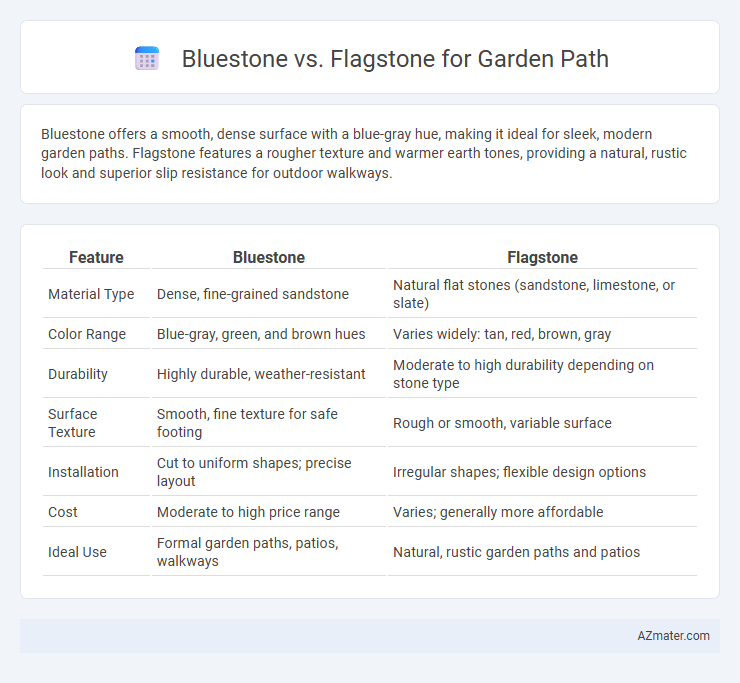Bluestone offers a smooth, dense surface with a blue-gray hue, making it ideal for sleek, modern garden paths. Flagstone features a rougher texture and warmer earth tones, providing a natural, rustic look and superior slip resistance for outdoor walkways.
Table of Comparison
| Feature | Bluestone | Flagstone |
|---|---|---|
| Material Type | Dense, fine-grained sandstone | Natural flat stones (sandstone, limestone, or slate) |
| Color Range | Blue-gray, green, and brown hues | Varies widely: tan, red, brown, gray |
| Durability | Highly durable, weather-resistant | Moderate to high durability depending on stone type |
| Surface Texture | Smooth, fine texture for safe footing | Rough or smooth, variable surface |
| Installation | Cut to uniform shapes; precise layout | Irregular shapes; flexible design options |
| Cost | Moderate to high price range | Varies; generally more affordable |
| Ideal Use | Formal garden paths, patios, walkways | Natural, rustic garden paths and patios |
Introduction to Bluestone and Flagstone Garden Paths
Bluestone and flagstone are popular choices for garden paths due to their durability and natural beauty. Bluestone, a dense, fine-grained sandstone, offers a smooth surface with blue-gray hues that complement various garden styles. Flagstone, characterized by its irregular shapes and warm earth tones, provides a rustic, textured appearance ideal for creating organic, natural-looking pathways.
Key Differences Between Bluestone and Flagstone
Bluestone is a dense, fine-grained sandstone known for its blue-gray color and smooth texture, making it highly durable and slip-resistant, ideal for garden paths requiring longevity. Flagstone, composed primarily of sandstone or limestone, offers a broader range of natural colors and a rougher surface, providing varied aesthetic appeal but slightly less durability under heavy foot traffic. The key difference lies in bluestone's uniformity and hardness versus flagstone's diversity in color and texture, influencing both visual style and maintenance for garden pathways.
Bluestone Overview: Appearance and Characteristics
Bluestone features a smooth, fine-grained texture with a rich blue-gray color that can range to hues of green and brown, making it a versatile choice for garden paths. Its dense composition provides excellent durability and slip resistance, ideal for outdoor walkways exposed to various weather conditions. The natural cleft surface of bluestone offers a rustic yet refined look, enhancing garden aesthetics while requiring low maintenance.
Flagstone Overview: Appearance and Characteristics
Flagstone features a natural, rustic appearance characterized by its flat, irregular shapes and earthy tones ranging from red and brown to gray and tan, making it ideal for garden paths that blend seamlessly with natural surroundings. Its sedimentary rock composition provides a durable yet porous surface that offers good traction and weather resistance, enhancing safety and longevity in outdoor environments. The versatility in thickness and size allows for customizable layouts, contributing to both aesthetic appeal and functional design in garden pathways.
Durability and Longevity Comparison
Bluestone offers exceptional durability due to its dense composition, resistant to chipping and cracking under heavy foot traffic, making it ideal for long-lasting garden paths. Flagstone, while visually appealing with its natural, irregular texture, tends to be softer and more prone to erosion, reducing its longevity in high-traffic areas. For garden paths requiring enduring strength and maintenance-minimal surfaces, bluestone outperforms flagstone in durability and longevity.
Cost Factors: Bluestone vs Flagstone
Bluestone typically costs between $6 and $15 per square foot, making it a mid-range option for garden paths, while flagstone ranges from $5 to $30 per square foot depending on the type and source. Installation costs also vary, with bluestone often requiring more precise cutting and leveling, potentially increasing labor expenses compared to many flagstone varieties that allow for more natural fitting. The durability and weather resistance of bluestone might reduce long-term maintenance costs, whereas flagstone's variable hardness can lead to more frequent repairs, impacting total cost-effectiveness.
Installation Process and Maintenance Requirements
Bluestone offers a smoother surface and uniform thickness, simplifying installation with fewer leveling adjustments compared to the more variable flagstone, which often requires custom fitting due to its irregular shapes. Maintenance for bluestone involves periodic sealing to prevent staining and weathering, while flagstone paths need more frequent cleaning and joint weed control because of their porous nature and uneven gaps. Both materials demand regular inspection for settling or shifting, but flagstone's uneven edges may require more attention to keep a stable, safe walking surface.
Climate Suitability and Slip Resistance
Bluestone thrives in colder climates due to its frost-resistant properties, making it ideal for garden paths in regions with frequent freeze-thaw cycles, while Flagstone performs well in warmer climates because of its natural heat resistance. Bluestone's textured surface offers excellent slip resistance, especially when wet, providing safer footing in rainy conditions, whereas Flagstone varies in slip resistance depending on its finish, with smoother surfaces potentially posing a greater slipping hazard. Garden path designers should consider Bluestone for durability and safety in wetter, colder environments and opt for Flagstone in drier, milder areas to balance aesthetics and functionality.
Aesthetic Options and Design Flexibility
Bluestone offers a smooth, uniform surface with bluish-gray hues that create a sleek, modern look for garden paths, complementing minimalist and contemporary designs. Flagstone provides a wider range of colors, textures, and irregular shapes, enabling more organic, rustic pathways that blend seamlessly with natural landscapes. The design flexibility of flagstone makes it ideal for creative, curvilinear layouts, while bluestone suits structured, geometric patterns for clean visual appeal.
Choosing the Best Stone for Your Garden Path
Bluestone offers a smooth, dense texture with consistent blue-grey hues that enhance contemporary garden paths, while flagstone provides natural variability, durability, and a rustic appearance ideal for traditional or informal settings. Consider factors such as climate resilience, maintenance requirements, and design style compatibility when choosing between bluestone's refined elegance and flagstone's rugged charm. Selecting the best stone depends on balancing aesthetic preference with functionality, including slip resistance, weathering properties, and installation cost.

Infographic: Bluestone vs Flagstone for Garden Path
 azmater.com
azmater.com